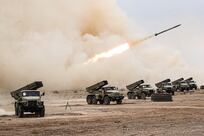The US Federal Reserve may be paving the way for more expensive crude by releasing floods of dollars as it seeks to boost sluggish domestic economic recovery.
"Cash and carry" hedging is now the principal driver of crude prices, not the fundamentals of supply and demand, said Dr Leo Drollas, the deputy executive director and chief economist of the London-based Centre for Global Energy Studies.
In his speech at the energy conference of the Emirates Centre for Strategic Studies and Research, Dr Drollas was referring to the investment practice of simultaneously buying a commodity and selling a contract for later delivery.
The hedger's guaranteed profit is the difference between the price of the futures contract and the lower spot price, minus storage costs.
"The oil inventory disequilibrium is the key determinant of oil prices," Dr Drollas suggested. "Oil prices are driven by discrepancies between demand for oil inventories and the inventories actually held."
Crude last week tested a 25-month high above US$87 a barrel in New York before pulling back slightly in the past two days.
The International Energy Agency (IEA) yesterday said crude could exceed $200 by 2035 as the world's conventional output flattens unless governments curbed consumption.
"The message is clear: the price will go up, especially if consuming countries do not make changes in the way they consume oil, especially in the transport sector," Fatih Birol, the chief economist of the IEA said as the agency released its 2010 World Energy Outlook.
The IEA advises 28 industrialised countries on energy issues, Dr Drollas predicted crude would exceed $90 a barrel by the end of next year. Investors' appetite for oil, which is priced in dollars on international markets, is whetted when US dollars become cheaper, he argued. That would usually trigger hedgers to buy oil on the spot market, pushing spot prices higher relative to futures contracts.
But a further wave of cheap money arriving before a new equilibrium has been reached can stimulate more hedging activity, which in turn keeps the futures curve tilting upwards and oil prices rising.
"It is now possible to identify the commodity pool operators, commodity trading advisers and hedge funds which are among the major players in the market," Dr Drollas said. "The data suggest that their positions correlate closely with oil prices. The cash-and-carry hedge has become extremely important."
Hedgers are responding to the expectation of a dollar glut as the Federal Reserve chairman Ben Bernanke prepares to embark on another round of quantitative easing.
Dr Drollas predicted that would push oil prices higher, despite the current brimming stockpiles that indicated ample supply. "Oil prices were rebounding at a time when the economy was still in deep recession. This may not have been due to OPEC cuts," he said. "If new money sets off a fresh wave of upward price expectations, the hedge funds become active again and the cycle restarts."
Dr Drollas said his theory was a "working hypothesis" that was "difficult to prove". But he noted prices for gold, silver and cotton were also near record levels, suggesting they were also responding to heightened hedging demand for inventories.




